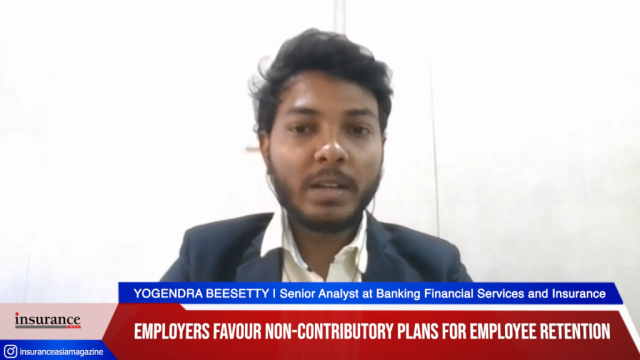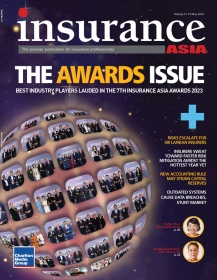
Inside blüüm's quest to bring health solutions to every lifestyle
With its insurtech partner CareVoice, it promises a user-centric and fully digital experience.
Given the ongoing pandemic, it’s only natural that people will focus more on their health and well-being nowadays, hence the uptick in the demand for health insurance plans. However, customers also want a more personalised journey to go along with it, something that will accommodate the needs of different population segments whilst taking advantage of the rapid digitisation to add value to their services.
Launched by insurtech startup CareVoice in early December 2020, blüüm is a platform which grants tailored health insurance based on what customers need and their lifestyles. It offers an all-in-one group medical insurance for startups and SMEs, as well as worldwide medical protection for sports lovers. Aside from flexible and cost-effective plans, clients can also enjoy a 24/7 virtual symptom checker and book appointments from an extensive medical network through an app.
Insurance Asia spoke with blüüm CEO Ying Wu and CareVoice co-founder and CEO Sebastien Gaudin to know more about what blüüm plans to bring to the market and how CareVoice can help insurers tap into more population segments through changing their ways of designing health insurance plans.
Can you tell the meaning behind the name blüüm and how it represents your vision for the platform?
Ying Wu: blüüm actually comes from the word "bloom" and as per Chinese tradition, it's related to mornings when the flowers are actually spreading. It implies that blüüm will be able to incentivise users with a higher quality of life throughout all life stages. Under a new approach to insurance plans and health services, you can see that we are rather different from traditional insurance brands. Whilst we bring the protection part, we're actually conveying a broader and more positive image for this portfolio of health insurance.
If you look at the logo of the brand, it is composed of two symbolic smiley faces in the middle and two different colors, blue and orange, which represents the logical side and creative side. The blue part means maturity, protection, and a rational way to protect your health whilst orange shows creativity, so basically the innovation and passion to live your life to the fullest, which is the basic principle of our branding. We wanted a combination of these two elements that will focus on our specialties: health services and protection.
What were the circumstances that led to the establishment of blüüm, and what gaps in health insurance are you trying to fill?
Sebastien Gaudin: At CareVoice, we focus on helping insurers fill the gap in terms of customer engagement and insurance product innovation. Insurers are quite far from their customers. As they create ways to engage with customers through mobile apps, they face low usage and offer very limited services. The insurance products are also quite similar to each other and do not really resonate with a specific segment of customers.
We built CareVoiceOS, the first healthcare operating system for insurers to help drive innovative customer engagement and population-specific insurance products, unlocking new ways of commercialization. As a tech company, we realized that to be able to get insurance companies adopting our tech stack and help them change the way they do things, we had to work closely with them to show how to use CareVoiceOS. We have designed new health insurance products hand in hand with insurers, and from there, we've started to help insurers commercialise their health insurance products. The very first step was with PingAn Health in Mainland China. They were not necessarily keen to let us manage their customers on our app and back then we could not offer yet bringing our services and customer experience inside the insurer apps, because they had their own app, but they were really interested about our customer journey and how we bring innovative services and customer digital experience tailored for relevant populations. So we decided with PingAn Health to go for a specific customer group, which are startups, and we created an innovative health insurance with relevant services for those startup staff. That product has been quite successful. It's where we decided to have a dedicated team to drive the commercialisation of innovative health insurance, and Ying came in to lead this team for that purpose.
Wu: We started with group insurance because we believed that it was a very nice space for our portfolio expansion. It is usually the first insurance that people own after they graduate and it also reinforces brand recognition. We follow a family-oriented life stage design that when you get your first insurance with your company, you then stay with the brand. After that, the brand can give you more offerings such as medical insurance and services for sports enthusiasts, critical illness for young professional women or even for parents and seniors.
We believe that these scenarios are creating different opportunities for blüüm to get into every aspect of family life and help customers live a better lifestyle, whilst in the backend we have CareVoiceOS to manage all the portfolios with the same tech stack. At the end, insurance companies can really tap into CareVoiceOS and also the strengths of blüüm, for an innovative and efficient way to commercialise population-specific health insurance products.
In your opinion, what makes you stand out from other insurtechs that offer similar services?
Gaudin: We don't see a direct competition with what we are doing. The main alternative to what we are offering is that insurers would keep doing customer engagements with simple apps or launching undifferentiated health insurance products. Insurers may contract with specific digital health service providers but they face lots of challenges. It takes lots of effort to source, contract and implement just one digital health service. These services are usually not integrated with the insurance products and the customer journey, thus have low utilisation rate and positive impact for both customers and insurers.
Our focus is to work closely with insurers and change the way of approaching the design of new health insurance products to be much more specific to a given population, looking at this population with relevant insurance coverage, well-being and health services that add value for customers but also have an impact on the insurance risk itself. Our DNA is very focused on healthcare and technology. If you look at the market very few insurtechs are actually dedicated to healthcare, and it gets more complex as you have to know the two industries' specificities. Whilst our team comes more from a healthcare background, we also have people from the insurance sector which I think can get us very strong in helping insurers, creating valuable health insurance and customer engagement.
Lastly, it is about this ability to commercialise and offer a full turnkey solution for insurance companies. For instance, there are some insurers that do not offer health insurance yet. They can turn to us and we are a very ideal turnkey solution, because we bring them the tech stack with innovative health services. We bring them new health insurance product concepts and get them to the market. For instance, very soon we'll announce two launches in Hong Kong and a P&C insurer in Mainland, where we are launching with them their first health insurance.
Wu: From a consumer perspective, we're able to actually bring a very flexible way for people to engage with their insurers, for plans, health services and protection.
Our products are designed based on the scenarios and the needs of customers, and we understand that those needs are very different and personalised. We have a tech engine to enable the flexibility of combining different health services and protection. In that way, we want them to be able to live their lives to the fullest. The new generation of customers expects to have a fully digitized customer experience. Powered by CareVoiceOS, blüüm can serve its customers efficiently whether using AI-based medical triage in case of symptoms or AI-based customer service in case of any questions or need to deal with their claims.
How do you envision the future of insurtech now that the world is re-emerging from the pandemic? How does that affect your strategies moving forward?
Gaudin: The pandemic has been accelerating some of the changes that were already happening in the industry. But the key trends that we see, and where we play a role, are in four dimensions.
First, insurance companies have realised that in health insurance, it's critical to have a connected ecosystem to be able to operate and more importantly, bring value to the end user and influence medical risk and consumption. Health insurance is a space where you have multiple stakeholders, where in order to be able to keep someone healthy or to address his/her medical issue, you may need to plug different types of services and technologies that can help achieve those goals. As an insurer, if you want to be able to address the needs of customers, you need to be able to engage with them—for instance, Prudential Asia, who had this large initiative with Pulse where they are plugging different digital health services. But that is very hard to achieve for non-technology players, and we see that most insurers don't have this capability of integration and how to put together a unified customer journey. This is where CareVoiceOS steps in: our connected ecosystem for health insurance is a very good answer to this trend.
A second one is population-specific insurance which we see as a strong change in the industry. Most of the products have been so far designed around categories of insurance, for instance coverage on top of social insurance, full private medical care, or for specific serious diseases. It is a matter of how much you pay: if you have a higher premium, you have a higher coverage. But how much of that resonates to who you are, to your own lifestyle, or the type of health service you may need and the health risk you may be exposed to? That's not targeting a specific population at all. If you are someone practicing sports or if you are a young parent of a family of three, your health needs and coverage are different.
Another one is the emergence of new non-insurance channels. Obviously, insurance products have been sold a lot through traditional offline channels and broker agents, and now more and more through online brokers or marketplaces. However, many businesses or communities are keen to expand their product offering such as bringing health services especially during the pandemic. Those businesses are also interested in increasing the lifetime value of their customers and become a new channel for health insurance. That's where we also play an active role, we can enable those channels and turn them into new distribution models for health insurance.
We are also seeing a longer term trend where insurers are leveraging more data for better risk assessment and dynamic underwriting, but this will come in the second stage because it's about accumulating the data first, and then being able to run models to analyse and extract value and predictive scores from the data. The first critical thing to do as an insurer is to make sure that you can collect and generate the data either from those new channels or from customer engagement. As soon as you create services and you can engage with the customers, you can get useful data that are important for risk assessment. That's an area where we are already active and that which will become more and more important in the next one to two years.
How does blüüm differ from traditional medical insurance plans in the market, aside from being focused more on SMEs and startups?
Wu: When we designed the blüüm team, we identified several segments with the key segment being group insurance segments. Group insurance is not a new concept, but we see that a lot of plans in the market are tailored to large corporates and multinational companies that are not suitable for smaller companies. The needs of SMEs are much more flexible, price sensitive and more health-services driven, so we designed blüüm team to address the unmet needs of these segments.
Before that, it was quite a challenge for the owners or HRs of SMEs to find a suitable plan and up to this point, there's still a big market vacancy so there is large growth potential for us in the coming years. We have seen that coverage is getting increasingly important in Hong Kong where a large population of employees are getting covered by commercial insurance but within the SME segment, it goes down to 15%, and in the Mainland it's even lower than 5%.
This is also a great community to give health services as employee benefits. A lot of these employers are paying more and more attention to what can be done to prevent any health problems. On one side they don’t want to pay much for these health plans and protections. On the other side, they don't want to lose employee working time due to bad healthy habits, not being able to detect early conditions or having to spend lots of time in the public healthcare system. The services that we provide are helping them promote healthy behaviours to their employees so that they can reduce the downsides of work and even reduce claims ratio which allow us to give them lower pricing.
Tell us more about blüüm sport, particularly the DNA testing aspect. Why did you choose to expand your offerings to sports lovers?
Wu: Our general rule in designing insurance protection is that we want to find a segment that has very unique characteristics in terms of community, has a common interest and is willing to promote health. Sports enthusiasts fit all of these criteria: they care a lot about their health, they do a lot of sports activities, and they are exposed to injuries. Bringing this a step further, we believe that our protection is not only an insurance plan but also a tailored health offering for a specific group.
We learn from the athletes who pay a lot attention to more than just the sports activities themselves. They pay attention to their body conditions, starting from the DNA testing, and they know that these tests can show how they can train better and eat better. The service that we provide has a 99.9% accuracy thanks to 31 million genetic data points. DNA testing is already being utilised in athlete training and we want to expand that to sports enthusiasts as well. By giving better diet advice and training tips, they will be able to perform better, and if they have injuries then we have services and protection from our insurance plan to cover them during rehabilitation.
I think that actually makes us stand out from other sports-related insurance plans or other scenario-based service packages that we provide both prevention and treatment services so that customers can enjoy a better experience.
What's next for blüüm?
Wu: blüüm woman is going to be launched in Mainland China in January and also in other markets. Women, both in their professional and personal lives, have been paying more and more attention to their health, especially seeking protection from critical illnesses. blüüm woman is going to be launched with a suite of relevant health services and an extra layer of protection.
In the product pipeline, we cover other untapped markets. Together with the CareVoice teams, we have designed around 15 new health insurance categories and partnered with insurers for at least half of them in Mainland China and Hong Kong. We're expecting to launch around two new products per quarter.
In summary, we are expanding our pipeline to give unique combinations of scenario-based health insurance and services to serve these segments better. We are targeting very specific customer groups that actually have a special interest in our product offering so that it increases the stickiness of customers as well.
Gaudin: We are preparing to launch blüüm woman with a leading insurer in Mainland China, while blüüm team was previously launched in partnership with PingAn Health in Mainland China and Generali in Hong Kong, and blüüm sport with AXA in Mainland China and another insurance player in Hong Kong.
With this product pipeline, we are working with leading insurers that are willing to change the way they approach the markets, going after a specific customer population, a very unique value proposition driven by health services on prevention of treatments, and also opening a new way of commercialisation with those non-insurance channels which have the appetite to help customers with more valuable health service and insurance. We're very excited about those partnerships with insurers, where CareVoice and blüüm can provide more valuable support and continue striving to make health insurance more human.






















 Advertise
Advertise










